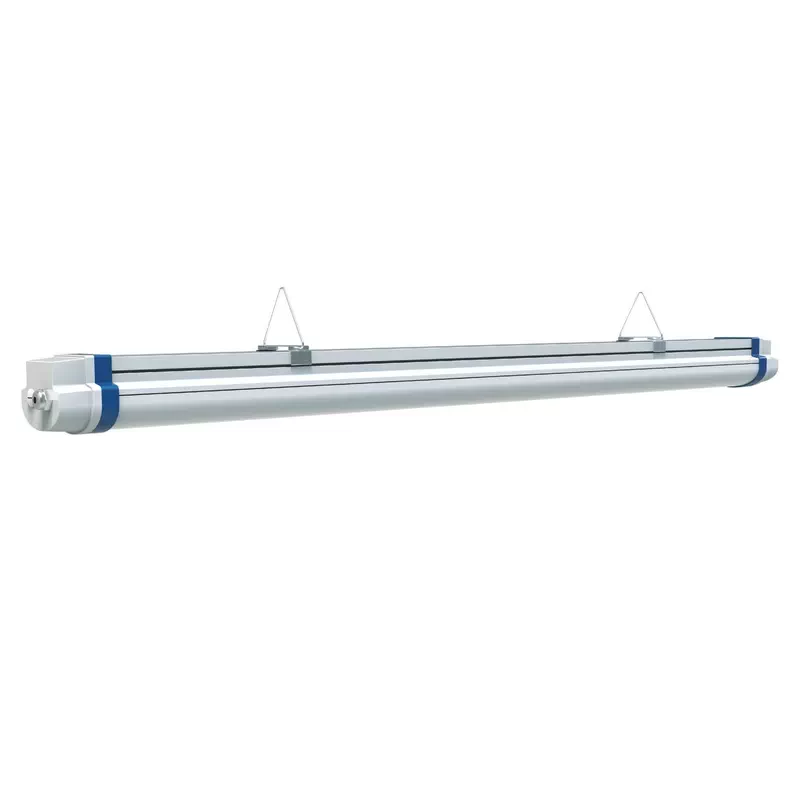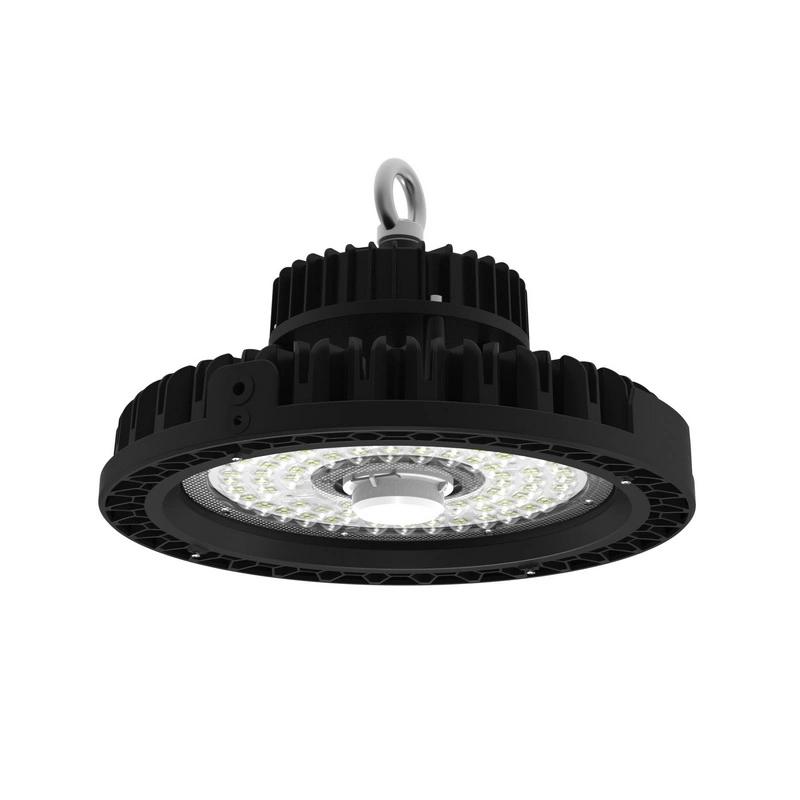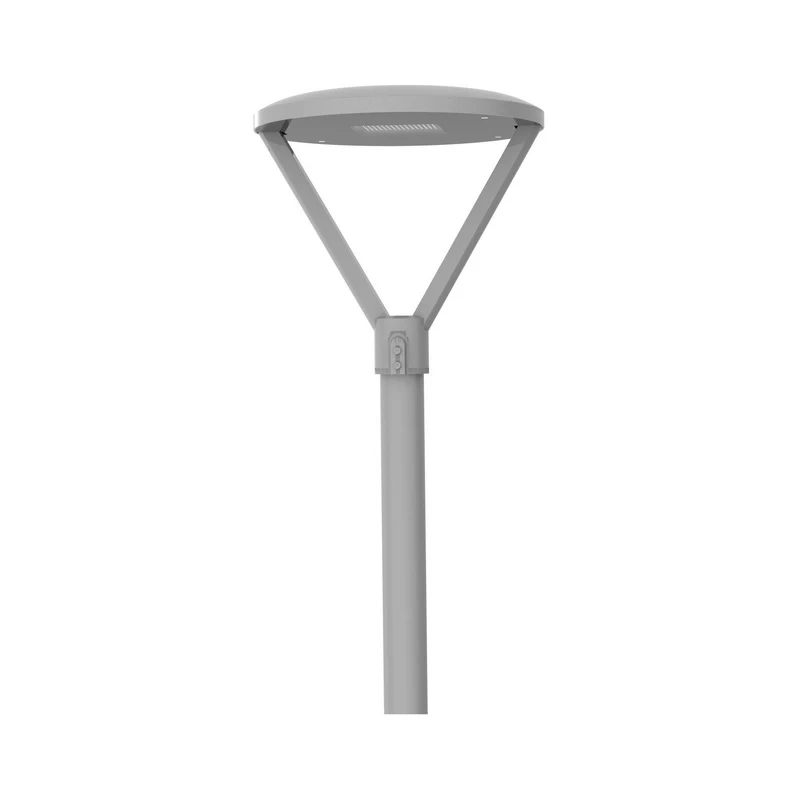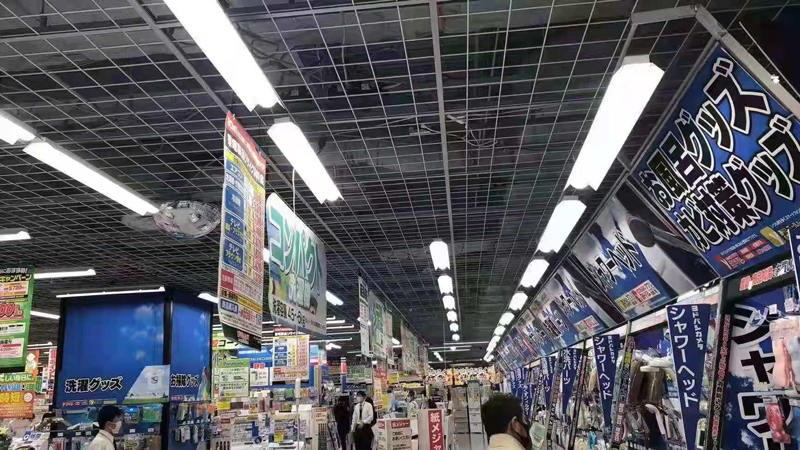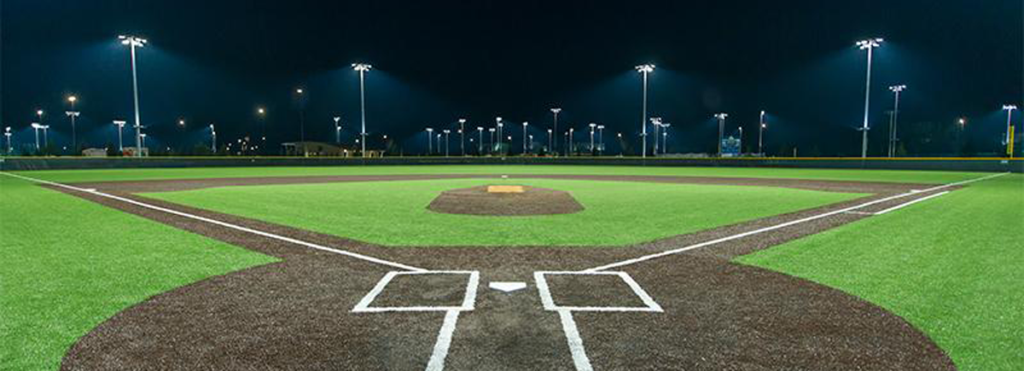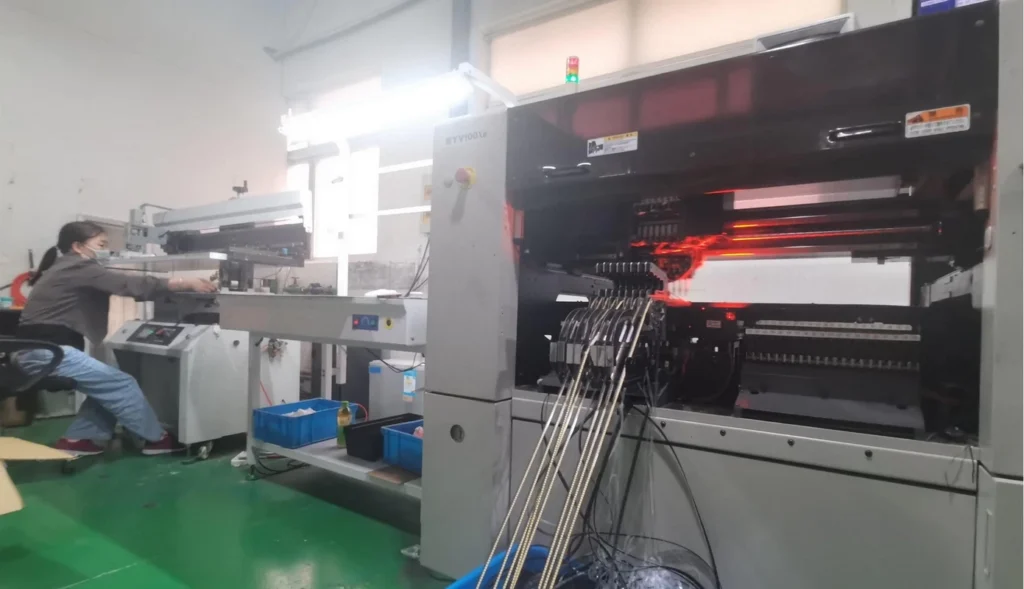Indice dei contenuti
Toggle1. Introduzione
I diodi a emissione luminosa, o LED, sono ormai comuni nell'illuminazione moderna. Stanno sostituendo le lampadine tradizionali, come quelle a incandescenza e fluorescenti. Fabbriche, negozi e stadi stanno rapidamente utilizzando luci LED di lunga durata. Queste luci sono efficienti dal punto di vista energetico, resistenti e durano a lungo.
Ma quanto durano effettivamente queste luci? Quanto durano le luci LED rispetto ad altre tecnologie di illuminazione? E soprattutto, in che modo le garanzie dei produttori possono garantire che l'investimento in lampadine e apparecchi LED sia redditizio?
Questo articolo parla della durata delle luci LED. Mostra come calcolarla e quali fattori influiscono sulla loro longevità. Questo aspetto è particolarmente importante per gli usi industriali su larga scala, come fabbriche, edifici commerciali e stadi.
Quanto durano le luci per negozi a LED?
Le luci per negozi a LED, comunemente utilizzate in garage, officine e spazi commerciali, hanno in genere una durata di vita compresa tra 50.000 e 100.000 ore. È possibile Visualizza tutti i nostri prodotti disponibili per l'illuminazione di qualsiasi negozio. Proprio come le lampadine LED standard, la loro durata effettiva dipende da fattori quali la dissipazione del calore, l'ambiente di utilizzo e la qualità del driver.
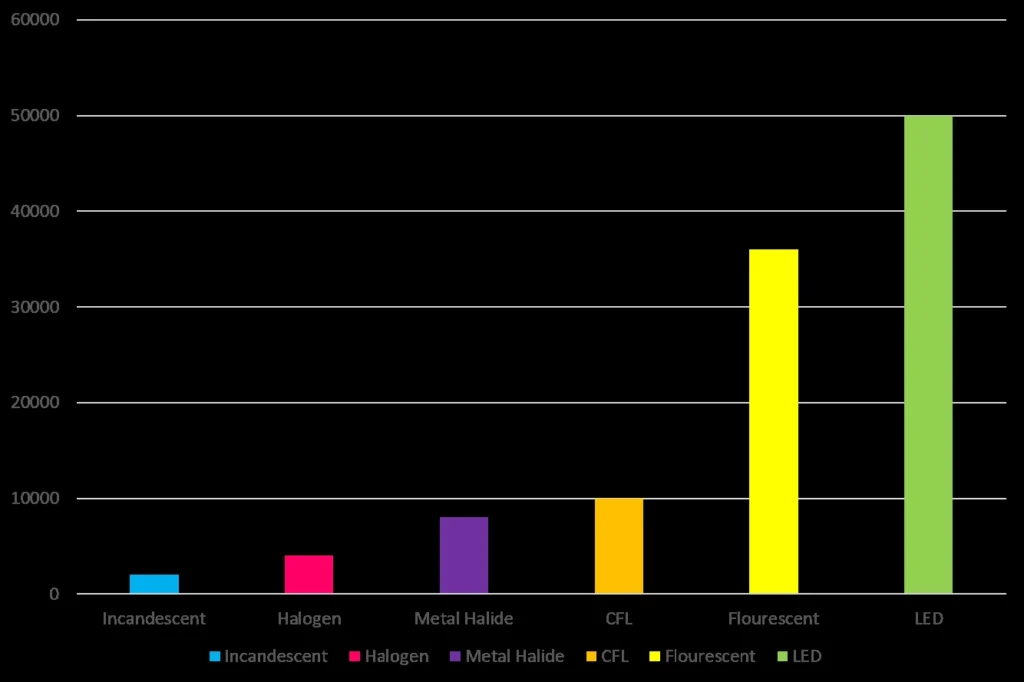
2. Qual è la durata di vita delle luci LED?
2.1 Introduzione ai concetti di base
La durata di vita delle luci LED si riferisce alla durata di funzionamento di queste luci prima che inizino a degradarsi o a guastarsi. Le luci a LED durano molto più a lungo delle normali lampadine a incandescenza, che di solito durano circa 1.000 ore. Ciò rende i LED una scelta affidabile per le grandi installazioni. In luoghi come fabbriche, negozi e stadi che necessitano di un'illuminazione luminosa e affidabile, le luci LED durano a lungo.
2.2 Confronto con le luci tradizionali
Le tecnologie di illuminazione tradizionali, come le lampadine a incandescenza e fluorescenti, impallidiscono rispetto ai LED per quanto riguarda la durata. Le lampadine a incandescenza durano solitamente tra le 1.000 e le 2.000 ore. Le lampadine fluorescenti, invece, possono durare dalle 10.000 alle 15.000 ore.
In alternativa, le luci a LED hanno una durata di vita compresa tra 25.000 e 50.000 ore o potenzialmente anche superiore. Ciò rende le luci LED di lunga durata la scelta migliore per i luoghi in cui l'illuminazione è importante, come fabbriche, palazzetti dello sport e negozi.
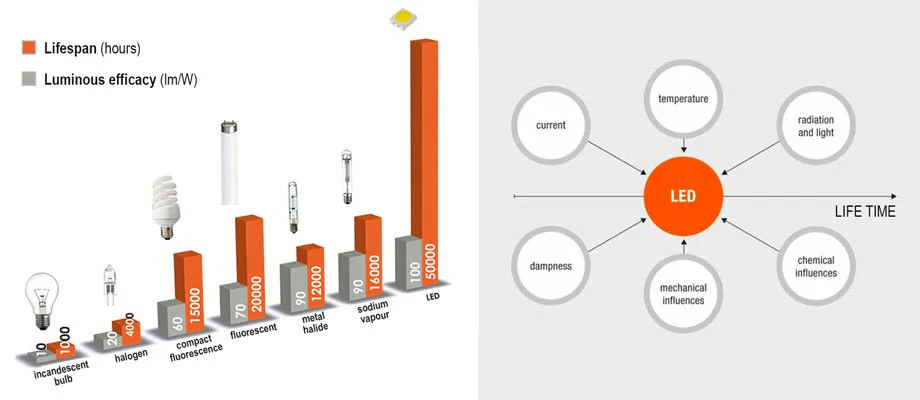
3. Come calcolare la durata di vita dei LED?
Le luci a LED durano a lungo, di solito tra le 25.000 e le 100.000 ore. Ciò dipende dal modo in cui vengono utilizzate e dalla loro qualità. Tuttavia, la conversione di queste ore in termini pratici, come gli anni, può aiutare gli utenti a capire quanto durerà il loro investimento.
Ad esempio:
- 50.000 ore in anni: Si tratta di una metrica comunemente utilizzata in ambito commerciale e industriale. Se una luce LED funziona 8 ore al giorno, può durare fino a 17 anni.
- A quanti giorni corrispondono 50.000 ore? L'utilizzo continuo delle luci, 24 ore su 24, 7 giorni su 7, equivale a circa 2.083 giorni o a circa 5,7 anni.
3.1 Calcolo della durata di vita in base ai modelli di utilizzo
La durata di vita delle lampadine LED varia a seconda del loro utilizzo. Ad esempio:
- Quanto durano i downlight LED? I downlight sono spesso utilizzati per l'illuminazione d'accento e possono durare fino a 25.000 ore.
- Qual è la durata delle plafoniere LED? Le plafoniere, soprattutto negli spazi commerciali, possono durare tra le 35.000 e le 50.000 ore.
- Quanto durano le lampadine a LED? Le lampadine per uso generale in casa o in ufficio durano solitamente tra le 25.000 e le 50.000 ore. Ciò dipende dal produttore e dalle modalità di utilizzo dei prodotti.
3.2 Importanza della garanzia del produttore
Quando si investe in luci LED per installazioni su larga scala, è fondamentale considerare la garanzia del produttore. Questa funge da rete di sicurezza per le aziende e le industrie. Garantisce che, in caso di guasto precoce delle luci, i costi di riparazione o sostituzione siano coperti.
Quanto durano le lampadine LED in base alla loro garanzia? In genere, la garanzia dura dai 3 ai 7 anni, a seconda della marca e della qualità del prodotto. LedRhythm offre garanzie estese per i suoi prodotti. Luci a LED per alte luci, industriale proiettorie le strisce LED. In questo modo, le loro prestazioni sono garantite per molti anni.
4. Quanto durano le lampadine e gli apparecchi a LED?
4.1 Quanto durano le lampadine LED?
Le lampadine a LED, a seconda della qualità e della marca, hanno una durata compresa tra 25.000 e 50.000 ore. In condizioni di utilizzo ragionevole, le lampadine LED possono durare più di 8-15 anni.
È importante notare che le lampadine a LED non smettono di funzionare dopo 50.000 ore. Utilizzano invece lo standard L70/L80. Ciò significa che dopo 25.000-50.000 ore, la luminosità del LED decade a 70% o 80% della sua luminosità originale, ma è ancora possibile utilizzarlo. Per saperne di più sul decadimento della luce e sulla durata della vita.
- Quanto durano le luci a batteria LED? Le luci LED portatili a batteria durano in genere circa 10.000 ore. Le luci LED industriali più grandi, invece, possono durare molto di più.
- Quanto durano le strisce luminose a LED con garanzia? Le strisce LED, come quelle utilizzate per l'illuminazione degli stadi, sono coperte da una garanzia che ne garantisce le prestazioni per 5-7 anni.

4.2 Quanto durano le lampade a LED?
La durata di un apparecchio LED può variare in base al design, alla gestione del calore e all'alimentazione. Quanto durano le lampade a LED?
In media, durano circa 50.000 ore. Tuttavia, in ambienti industriali e commerciali, gli apparecchi LED di alta qualità possono durare anche di più. I progettisti creano apparecchi LED integrati, come quelli della linea LedRhythm, per un uso a lungo termine. Funzionano bene anche in ambienti difficili.
4.3 Comprensione del periodo di garanzia
Molti produttori offrono garanzie che vanno dai 5 ai 10 anni, a seconda del prodotto LED. Ad esempio:
- Quanto dovrebbero durare le lampadine LED in garanzia? Se il prodotto si guasta durante il periodo di garanzia, di solito l'azienda lo sostituisce gratuitamente. Questo lo rende un buon investimento per le grandi installazioni.
- Quanto durano le luci LED con la garanzia? Le luci LED di Ledrhythm, come quelle utilizzate per l'illuminazione degli stadi, sono coperte da una garanzia di 5 anni.
5. Fattori che influenzano la durata di vita dei LED
5.1 Gestione del calore
Il calore è uno dei fattori che più incidono sulla durata delle luci LED. Una cattiva gestione del calore può portare i LED a bruciarsi prematuramente o a degradare la loro luminosità nel tempo.
5.2 Alimentazione
Un'alimentazione costante e stabile è essenziale per la lunga durata delle luci LED. Le fluttuazioni di potenza possono ridurre la durata di vita dei LED. Per questo motivo la corretta regolazione della tensione è importante nelle fabbriche e negli edifici commerciali.
5.3 Qualità del chip LED
La qualità del chip LED utilizzato nella lampada ne determina la durata. I chip di qualità inferiore possono degradarsi più rapidamente, con conseguente riduzione della durata di vita. Gli ingegneri progettano LED di qualità superiore, come quelli presenti in Prodotti LedRhythmper una lunga durata in ambienti industriali.
5.4 Condizioni di utilizzo
Anche l'ambiente operativo gioca un ruolo nel determinare la durata delle luci LED. Ad esempio, le luci a LED che si trovano a temperature estreme o ad alta umidità possono usurarsi più rapidamente di quelle che si trovano in altri ambienti.
6. Modi per prolungare la durata di vita delle luci LED
6.1 Verifica della fonte di alimentazione
Assicuratevi che l'impianto elettrico fornisca un'alimentazione costante e stabile. Le fluttuazioni di tensione possono danneggiare le luci LED e ridurne la durata.
6.2 Spegnimento delle luci quando non vengono utilizzate
Uno dei modi più semplici per prolungare la durata di vita delle luci LED è spegnerle quando non vengono utilizzate. Negli ambienti industriali, l'uso di sensori o sistemi di automazione può aiutare a gestire questo aspetto.
6.3 Scegliere prodotti di alta qualità
Optate per prodotti LED progettati per durare nel tempo, come quelli offerti da LedRhythm. Fornisce un'illuminazione LED speciale per fabbriche, aziende e stadi.
6.4 Manutenzione ordinaria
Pulendo e ispezionando regolarmente le luci a LED si può evitare che polvere e sporcizia ostacolino la dissipazione del calore. Ciò contribuisce alla longevità delle luci.
6.5 Installazione in ambienti adeguati
Assicuratevi che le vostre luci LED siano installate in ambienti adatti al loro design. Ad esempio, utilizzate luci LED coperte in aree ad alta umidità. Evitate di utilizzare apparecchi chiusi con lampadine non adatte a queste condizioni.
6.6 Luci LED di Ledrhythm
Il marchio LEDRHYTHM si concentra da 10 anni sulla produzione di soluzioni di illuminazione industriale a palo alto. Il nostro team dispone di ingegneri ottici esperti in R&S e di attrezzature professionali.
L'officina della nostra fabbrica si estende per oltre 10.000 metri quadrati. Serviamo più di 5.000 clienti, sia nazionali che esteri. Questo ci rende leader nel settore dei LED.
- Dissipazione del calore: Ogni lampada LEDRHYTHM consente una buona dissipazione del calore. Ciò contribuisce a ridurre la temperatura di esercizio del chip LED. Inoltre, rallenta il decadimento della luce e prolunga la vita del LED.
- Driver: Il driver è un componente chiave per fornire corrente e tensione stabili al LED. Per fornire un'alimentazione stabile ai LED, LEDRHYTHM utilizza driver di alta qualità di marche rinomate. Ciò consente di ridurre la corrente e la tensione.
- Qualità: Anche la qualità dei LED è un fattore importante per determinare la durata di vita. L'utilizzo di componenti LED di alta qualità e di materiali resistenti e durevoli con una buona conduzione del calore può aiutare le nostre lampade a durare più a lungo.

7. Le persone chiedono anche
Quanto durano le luci LED in condizioni normali?
Questo presuppone un uso normale, senza che altri fattori interferiscano. Ad esempio, le luci devono essere tenute a una temperatura moderata, asciutte e prive di polvere, con una tensione stabile e senza accensioni e spegnimenti frequenti.
Le luci LED industriali e commerciali superano in genere la durata di vita teorica degli standard L70/L80, superando spesso le 50.000 ore.
La lampadina LED non può più essere utilizzata una volta esaurita la sua aspettativa di vita?
Ovviamente no. L'aspettativa di vita di una lampadina a LED si riferisce al tempo necessario affinché la luce si riduca a un livello standard. È ancora possibile utilizzare la lampadina, ma la sua luminosità sarà sensibilmente inferiore.
Cosa c'entra la durata della luce LED?
- Dissipazione del calore: Una migliore dissipazione del calore significa una maggiore durata; il surriscaldamento accelera il decadimento della luce e l'invecchiamento dei componenti.
- Qualità dell'alimentazione: Un'alimentazione di alta qualità, stabile e affidabile può prolungare la durata complessiva.
- Ambiente di utilizzo: Temperature elevate, umidità elevata e ambienti polverosi possono ridurre la durata di vita.
- Tempo e frequenza di accensione: Sebbene i LED siano resistenti a frequenti cicli di accensione e spegnimento, un utilizzo prolungato e ad alta frequenza può comunque compromettere la durata dell'alimentatore.
- Qualità dei chip LED e dei materiali: chip di alta qualità e materiali resistenti alle alte temperature possono prolungare notevolmente la durata di vita.
- Stabilità della tensione: Grandi fluttuazioni di tensione possono danneggiare i circuiti.
L'ambiente di utilizzo delle luci per negozi a LED ne prolungherà la durata?
Sì, perché la durata delle luci LED è influenzata dalla temperatura, dalla frequenza di commutazione e dalla tensione.
Le luci per negozi a LED sono generalmente utilizzate in spazi ben ventilati, stabili e privi di polvere. La loro durata effettiva può superare quella teorica.

